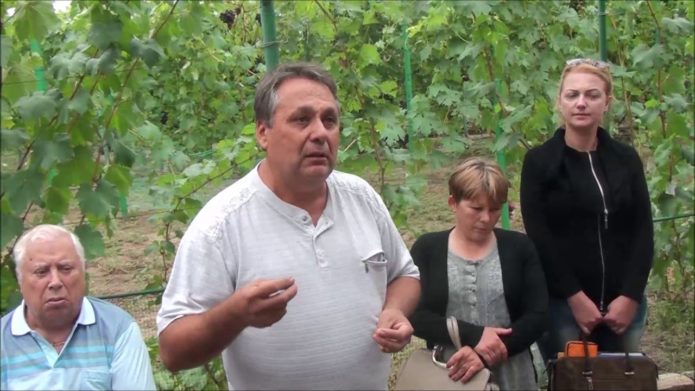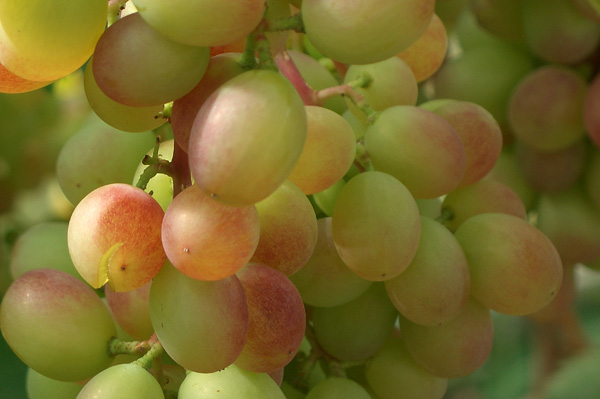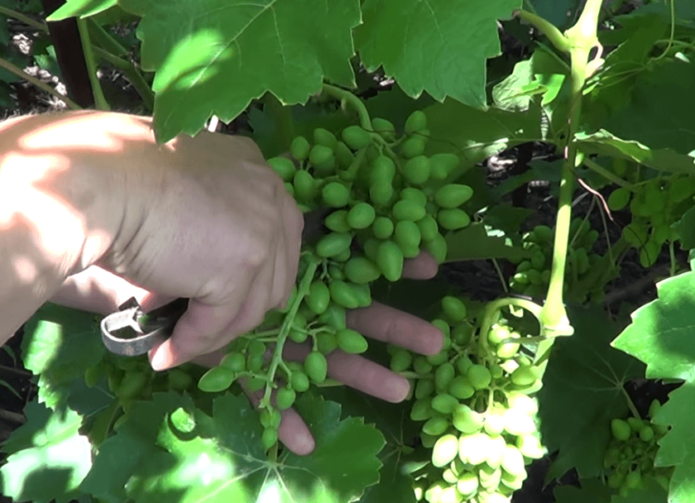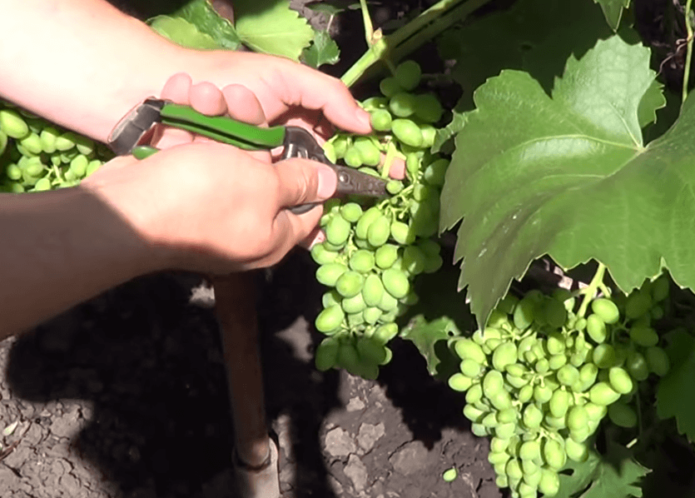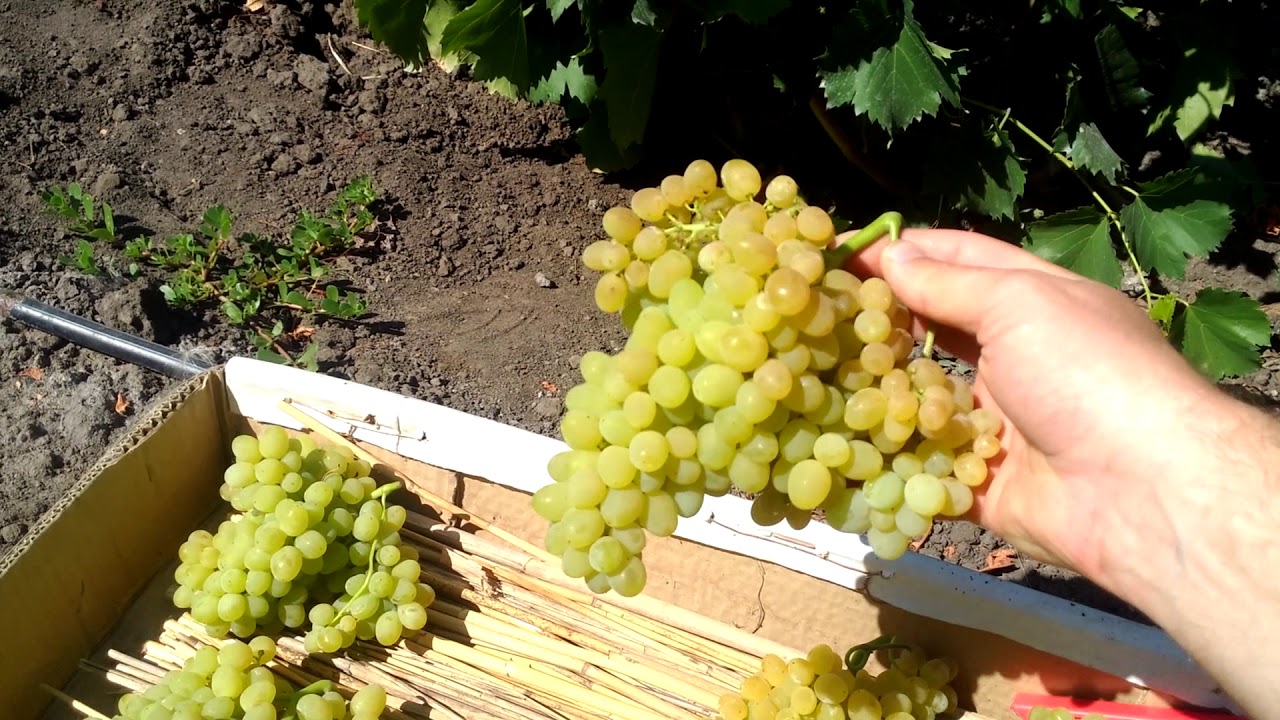The hybrid form of Sofia conquers the hearts of winegrowers with heavy bunches of large pink berries with a nutmeg aroma. However, the variety has already been called capricious, requiring non-standard care. There are drawbacks that you have to put up with for the sake of a large harvest of delicious and beautiful grapes.
Content
History and description of the Sofia variety
Sofia is a grape of amateur selection, it was created by the Ukrainian winegrower Vitaly Vladimirovich Zagorulko. He is also the author of such hybrid forms as: Bozena, Livia, Lily of the Valley, Veles, Mavr, Furshetny, Sphinx, etc. Sofia was obtained by pollination of the varieties Arcadia and Kishmish radiant.
The appearance of Sofia has caused a revival in the forums of winegrowers. Some dreamed and could not buy seedlings, while others had already acquired scarce planting material and were just beginning to test it on their plots. The variety really has many positive qualities and deserves attention:
- The bush has great vigor: the vines are thick, the leaves are large and slightly dissected.
- Saplings take root well, cuttings quickly grow roots, and grafts grow together easily.
- Bunches ripen in 110–115 days, very large - up to 3 kg, average weight - 1.5–2 kg.
- The berries are pink, each weighing 10–20 g. The pulp is juicy, fleshy, tasty, with delicate nutmeg. The peel is not felt when eaten, the bones are small, 1-2 per berry.
About 10 years have passed since the time when gardeners just started to grow Sofia in their gardens and get acquainted with this hybrid form. Now her seedlings are not in short supply. They spread throughout Russia. Rooted cuttings are sold even in gardening shops in Siberia.

Without thinning, the bunches of Sofia grow very dense, the berries crush each other, burst, and are affected by gray rot
The positive properties were confirmed. Sofia is called a promising commercial variety; beautiful bunches of grapes are quickly sold out on the market. In southern regions with a favorable summer, up to 30 bunches ripen on an adult bush. Even if you multiply by the average weight of one brush, then the yield of the bush will be 45-60 kg. In Volgograd, with skillful care, Sofia gives more than 10 kg of berries from a bush (6 bunches) already in the second year. It grows well on arbors and trellises.
However, there is no more excitement around the variety. As a result of tests on amateur and farm plots, Sofia showed all its negative sides. If it rains during the ripening period, the berries will crack, become infected with gray rot, or be attacked by wasps. Another significant drawback is very dense clusters, in some years they are similar to corn cobs. Due to the tightness, the berries are choking inside, the brush begins to rot from the inside.
Despite the early ripening period, Sofia does not ripen in the middle zone, and even more so in Siberia. In these regions, large-fruited grapes simply lack warmth. In the southern regions, it begins to ripen in early August, and in an unfavorable summer, the harvest shifts by 2-3 weeks. The variety requires preventive treatments for fungal diseases. In winter it can withstand frosts down to -21 ⁰C. Flowers in the hybrid form Sophia of the female type. Very well pollinated if other varieties grow nearby. Arcadia is considered the best pollinator.
Knowing the disadvantages of grapes, it is much easier to grow it. It is only worth taking on the experience of already established owners of this hybrid form. By the way, they are happy to pay special attention to Sophia, because the variety is very responsive to care and generously thanks for it.
Video: overview of Sofia grapes
Features of planting and care
When choosing a place, keep in mind that Sofia grows as a powerful bush. Leave the distance between the seedlings 3-4 meters. Grapes need a lot of sun and warmth, however, they themselves provide a strong shade. Therefore, a logical solution would be to plant it on the south side of the building or grow it in an arbor form.
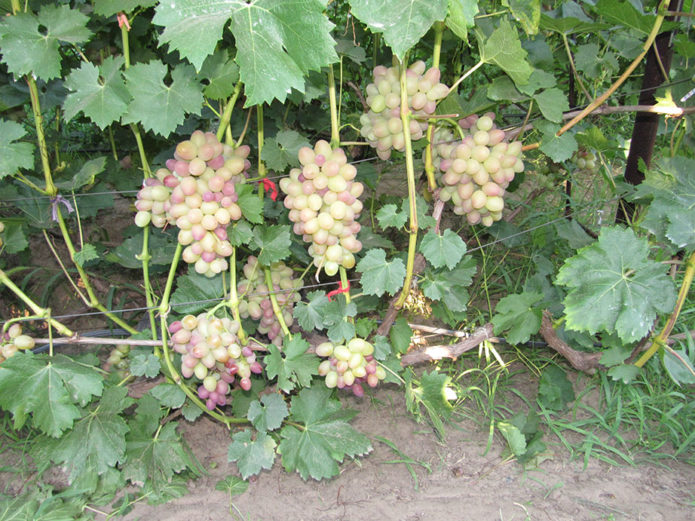
Sophia's spreading bush with thick vines and large leaves will take up a lot of space in your garden
A pit for Sofia needs to be dug large: with a depth and width of 80 cm. Put 2-3 buckets of organic matter (humus, compost) on the bottom, make a layer of ordinary earth and plant grapes. After planting, pour 1-2 buckets of water into the hole and mulch. In the first year, the growing shoots can be tied to stakes, but by the next seasons, be sure to build reliable supports.
Video: about the problems of growing Sofia
Watering and feeding
An ideal option for Sofia would be drip irrigation, then the ground will be constantly wet. In working with these varieties, sharp changes should not be allowed, when they do not water for a long time, there is a drought, and then there is a downpour or abundantly irrigated. If this happens during the ripening period, then the berries crack and rot. In August, watering should be excluded altogether. And before the oncoming downpour, put roofing material or slate sheets under the bush, so that the water does not fall to the root, but flows down the sides.
There are also peculiarities in applying dressings. A vigorously growing variety does not need an abundance of nitrogen fertilizers. It is enough in late autumn or spring to scatter 1-2 buckets of humus under the bush and loosen it up. Refuse mullein infusions and droppings, it is better to purchase complex mixtures with micro and macro elements in the store. They should contain less nitrogen than potassium and phosphorus. Do this twice: during the growth of green shoots and during flowering.
Bush formation
On the site of the author of the variety, V. V. Zagorulko, it is recommended to cut the fruiting vines of Sofia into 4–8 buds. However, the descriptions and cultivation methods are given for regions with favorable conditions for viticulture. In particular, Sofia was bred and shows itself well in Ukraine, in Zaporozhye. In Russian territories, you need to independently look for an approach to this variety and experimentally find out: how many sleeves need to be formed, how long the vines should be, how to ration the harvest so that all the bunches have time to ripen. Moreover, underload for Sofia is just as unacceptable as overload.
Video: how to cut grapes on an arch (gazebo)
Rationing, thinning of bunches
Many Sofia owners have faced the problem of too dense bunches. The berries crowd each other, become compressed at the base, like corn kernels, continue to pour, burst and rot. But such a nuisance does not happen every year. This factor is influenced by weather conditions, it is possible, and the underload of the bush, that is, all the juices go to a few bunches.
Knowing about Sophia's tendency, you can do prevention - thin out the berries in the brush. The event is recommended to be carried out in 2 stages:
- At the stage when the ovaries have just formed, they are the size of a pea, take scissors and cut all the berries along the stalk on one side. You can make the track 1–2 cm wide, or cut out the entire left or right side. When filled, the berries will fill the void, the brush will grow even.
- When the berries have reached half their size, you can do a second thinning by cutting out single fruits from different places in the bunch. But this is necessary only if, after the first thinning, the berries have grown so much that they are again located close to each other.
On average, when standardizing bunches of Sofia, 30–40% of the berries are removed. But there is an experience of removing more than half of the ovaries in two steps, the bunch after that still grew full-bodied with large berries.
Video: thinning the bunches of Sofia
Disease prevention
Sofia is affected by powdery mildew and mildew, but standard treatment is sufficient to protect against these diseases. It consists of two spring sprays:
- the first - on the blossoming leaves;
- the second - 10-14 days after the previous one.
All fungal diseases of grapes are treated with the same fungicides. The most popular among them are Bordeaux liquid, Topaz, Quadris, HOM, Skor, etc.
Shelter for the winter
In southern regions with mild winters, Sofia can be grown uncovered. However, even there growers prefer to lay the vines on the ground and cover them with reed mats to protect them from freezing rains. In regions with frosty and snowy winters, it is enough just to lay the grapes on a dry bed and sprinkle with loose earth.
If there is little snow, there are both frosts and thaws, then you need a better shelter:
- build a box around the bush;
- lay dry mulch on its bottom, and grape shoots on it;
- cover with breathable insulation (agrofibre, spruce branches, hay, etc.);
- crown the entire structure with a roof made of waterproof material (film, slate, tarpaulin, roofing material).
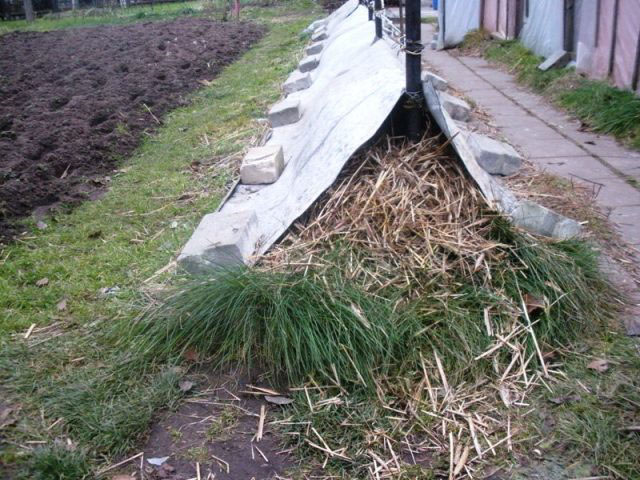
The method of shelter depends on the characteristics of winter in the growing region, in any case, the grapes must be protected from dampness and frost
Grape harvest Sofia, its purpose
The crop must be harvested as it ripens. The opinions of growers about overexposed bunches on the vine differ. Some say that over time, the aroma only intensifies, sugars accumulate, to others, overripe berries seem watery, the aroma, on the contrary, is lost. And you also have to find out empirically. The flavor depends a lot on the structure of the soil and the weather during ripening. On waterlogged land, with a lack of trace elements and a deficiency of the sun, the fruits can be tasteless. If they ripen in the heat, with a lack of water, then the concentration of sugars, esters and other elements that affect the taste will be higher.
Grapes contain natural sugars, vitamins A, C, E, group B, organic acids, pectins, as well as magnesium, calcium, phosphorus, potassium, iron and other macro- and microelements.
It is better not to overexpose the bunches of Sofia on the bushes, ripe berries can spoil: the scorching sun, rains, birds, wasps and rot. For the market, long-term storage, transportation, cut off the bunches without touching the berries, so as not to erase the wax coating on them. This is a table grape variety, which means that its main purpose is fresh consumption. However, thanks to the juiciness of berries and the presence of nutmeg aroma, Sofia is also used in winemaking, both solo and in blends with other varieties.
Video: how to keep fresh grapes before the New Year
Winegrowers reviews
Sofia has a functional-female type of flower, but she is perfectly pollinated, even beyond measure, and therefore either work with scissors or treatment with stimulants. I am not a supporter of the use of HA, therefore in the pea stage I cut a path along the bunch (up to 1 cm) in my conditions, this is enough so that the brushes are not too dense and the berry does not choke.When fully ripe, the berry is tasty, sweet with fleshy pulp and nutmeg, our family loves its taste. It colors the main crop poorly, and the stepson has a very beautiful color.
He left Sofia's signaling hanging, as a result: the berry lost its former taste and consistency, the skin is thick and the flesh is watery, the nutmeg tones disappeared in the taste. Sophia should never be overexposed.
If in some varieties the cracking seems to be overgrown, then in Sofia the burst berries begin to rot. Especially those that I put in tulle bags. Not closed just a paradise for bees and all kinds of insects.
Sofia and Kishmish radiant in the open ground, our vine does not fully ripen in any way, but in greenhouses it ripens well.
The variety is still whimsical - it requires normalization with scissors, it is prone to gray rot and cracking from oidium. Conclusion - based on your own bush and two from a neighbor.
Sofia grapes require a special approach. It is necessary: to give complex fertilizing, keep the soil constantly moist, normalize the bunches. Owners have to independently choose the degree of load of the bush, corresponding to the climatic conditions of the growing region. But special care pays off with a good harvest of quality berries.
